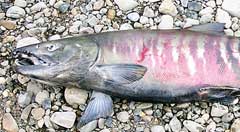
Sheenjek River
Fish
The Fish
Of the five salmon species found in the Yukon River drainage, chum salmon are the most abundant and occur in genetically distinct summer and fall runs. At the Sheenjek sonar site, Alaska Department of Fish and Game only monitors Yukon fall chum salmon, which are larger, spawn later and are less abundant than summer chum salmon. Fall chum spawn in upper portions of the Yukon drainage in spring-fed streams, which usually remain ice-free during the winter. Major fall chum salmon spawning areas within the Yukon drainage include the Tanana, Chandalar and Porcupine river systems (including the Sheenjek), and portions of the upper Yukon River in Canada. The Sheenjek River is one of the most important producers of fall chum salmon in the Yukon River drainage.
Fall chum salmon are harvested for commercial and subsistence uses. Yukon drainage commercial harvests occur in the main stem Yukon River and lower portion of the Tanana River, with most of the catch taken in the lower river, downstream of the village of Anvik. Subsistence use of fall chum salmon is greatest throughout the upper river drainage, upstream of the village of Koyukuk.
ADF&G uses several Biological Escapement Goals to manage Yukon drainage fall chum salmon, including a BEG for fall chum passage past the Sheenjek River sonar site. The Sheenjek River BEG as of 2011, was 50,000 to 104,000 fall chum salmon. Sheenjek River escapement estimates averaged 96,055 from 1981 to 2010 and 70,429 from 2006 to 2010.


